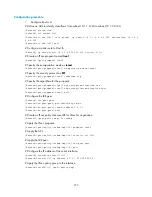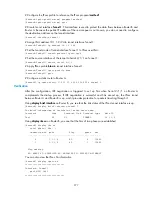
284
# Set the pre-shared key.
[RouterA-ike-peer-peer] pre-shared-key abcde
# Specify the IP address of the peer security gateway.
[RouterA-ike-peer-peer] remote-address 2.2.2.2
[RouterA-ike-peer-peer] quit
# Create an IPsec policy that uses IKE.
[RouterA] ipsec policy map1 10 isakmp
# Reference IPsec proposal
tran1
.
[RouterA-ipsec-policy-isakmp-map1-10] proposal tran1
# Reference ACL 3101 to identify the protected traffic.
[RouterA-ipsec-policy-isakmp-map1-10] security acl 3101
# Reference IKE peer
peer
.
[RouterA-ipsec-policy-isakmp-map1-10] ike-peer peer
# Enable dynamic IPsec RRI and use 1.1.1.2 as the next hop of the static route.
[RouterA-ipsec-policy-isakmp-map1-10] reverse-route remote-peer 1.1.1.2
[RouterA-ipsec-policy-isakmp-map1-10] quit
# Apply IPsec policy
map1
to interface GigabitEthernet 1/0/1.
[RouterA] interface gigabitethernet 1/0/1
[RouterA-GigabitEthernet1/0/1] ipsec policy map1
[RouterA-GigabitEthernet1/0/1] quit
2.
Configure Router B.
# Configure ACL 3101 to identify traffic from subnet 10.5.5.0/24 to subnet 10.4.4.0/24.
<RouterB> system-view
[RouterB] acl number 3101
[RouterB-acl-adv-3101] rule permit ip source 10.5.5.0 0.0.0.255 destination
10.4.4.0
0.0.0.255
[RouterB-acl-adv-3101] quit
# Configure a static route to subnet 10.4.4.0/24.
[RouterB] ip route-static 10.4.4.0 255.255.255.0 1.1.1.1
# Create IPsec proposal
tran1
.
[RouterB] ipsec proposal tran1
# Set the packet encapsulation mode to
tunnel
.
[RouterB-ipsec-proposal-tran1] encapsulation-mode tunnel
# Use ESP as the security protocol.
[RouterB-ipsec-proposal-tran1] transform esp
# Use DES as the encryption algorithm and SHA1-HMAC-96 as the authentication algorithm.
[RouterB-ipsec-proposal-tran1] esp encryption-algorithm des
[RouterB-ipsec-proposal-tran1] esp authentication-algorithm sha1
[RouterB-ipsec-proposal-tran1] quit
















































